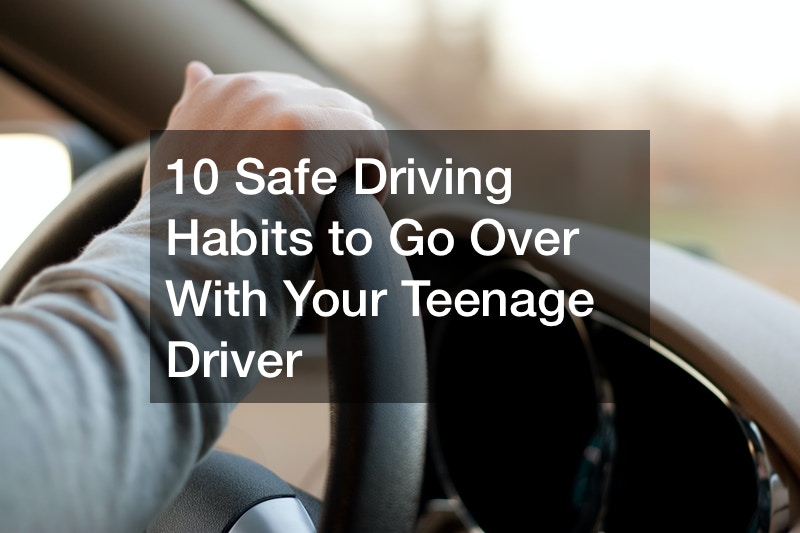
Have you talked with your teen about good driving habits lately? There are 10 safe driving habits that every teenager should know before getting behind the wheel. Driving is a big responsibility, and at this age there more distractions than ever before. There are a few tips to keep in mind for the next talk with your teen about driving.
For instance, the style of driving used on the road today is different from 20 years ago. Although some basic principles still apply, teaching your teenager as much as possible about driving is critical. Good habits are critical. The more applicable knowledge your teenager has about driving, the safer they can be for themselves and others on the road.
Being safe on the road extends beyond their initial surroundings. Driver safety includes road etiquette, staying aware of surroundings, and always following the law as well.
1. Operating the Vehicle

The first of these 10 safe driving habits involves operating the vehicle. Driving to the grocery store or your local coffee shop requires skill. In correlation to this, operating a vehicle begins with learning the basics. Some driving habits can be taught in a parked car. It is imperative to teach your teen in an environment without distractions. It is time to drive in the seven basic environments after the basics are mastered. Each skill should be performed without nervousness.
The seven basic driving environments are:
-
- Country or rural roads
- Commercial rraffic roads (with commercial truck
- Small and main highways
- Residential streets
- Empty parking lots
- Downtown roads
The nuts and bolts of operating a vehicle begin with knowledge of the vehicle that your teen will be driving. This includes any similar car that will be driven.
Today, vehicles have more features than ever before. Although this can be great for many safety reasons, teaching your teen how to drive without, for example, auto lane assistance or automatic parking is a good idea. These features can be taught after the essentials have been grasped. Going over the owner’s manual of the car is a great idea. Many owners’ manuals are available through the manufacturer, or online. Also, owners’ manuals for classic cars can be purchased online too.
The fundamental driving operations are:
-
- Adjusting the driver’s seat for safety.
-
- Adapting seatbelts properly as a habit.
-
- Making sure that all mirrors are properly adjusted for best vision.
-
- Knowing where the gear-shifter is located.
-
- Braking and acceleration. Located the brake and accelerator. (including the clutch in a car with manual transmission).
-
- Proper hand alignment on the steering wheel.
-
- Locating the emergency brakes
-
- Operating emergency lights
Shifting forward, after the manual has been obtained, your teen should learn how each control of the car works. This is including knowing why the controls are there. Operating the controls of the vehicle include indicator lights, what each one means, and how to use each control. Knowing these fundamentals can ease anxiety and nervousness. More importantly, knowing these 10 safe driving habits can keep your teen and other drivers safe.
2. Weather Conditions on The Road
The second of these 10 safe driving habits is being aware of the dangerous weather conditions on the road and how to navigate them. These weather conditions include:
-
- Hailstorms
-
- Heavy Fog
-
- Light to Heavy Rain
-
- Ice and Snow
-
- Bright or Extreme Sunlight
In a hailstorm, it is important to teach your teen to lower their driving speed and triple the distance between themselves and other vehicles ahead. Also, pulling over to a safe spot off-road such as a furniture store or other public parking lot and waiting it out is a safe tactic. Pulling over can decrease the damage to the vehicle and keep the driver off dangerous roads during the storm. Also, staying in the car or vehicle being driven will prevent bodily injury. Seeking shelter under a nearby canopy such as a gas station covering can help as well.
Driving under foggy conditions can reduce your teen s vision of the road drastically. If driving in the fog, do not turn on high beam lights. High beam lights can make it harder to see because of the lights’ reflection. Use regular beam lights to see ahead. Keep a long distance between yourself and other drivers. This will give you more time to react to anything that is on the road and time to stop suddenly. Additionally, Use the white line on the road to guide the vehicle to your destination. This will your teen to stay in their lane and drive when there is any glare from other vehicles.
Light to heavy rain can cause the roads to be slippery. Remember that your regular beamed headlights should be used in this situation. Also, it is key to stay in the middle lanes as much as possible. Normally pools of rainwater will be at the edge of the roadways. Pools of water can cause the vehicle to flood out or hydroplane.
Ice and snowy conditions can make driving more difficult. Always make brakes are in great condition at all times. Vehicles do not perform the same throughout all the yearly seasons. Learning how to drive in these conditions in a safe area is key, such as a vacant parking lot. Drive slowly and gradually let the vehicle speed up to similarity. Black ice can seem invisible to a driver’s eye at times. Areas such as bridges are prone to ice on cold days and should be driven across at a slower but steady speed.
Driving when there is a glare or extreme sunlight can be managed with care. The sun’s glare can cause a driver to lose vision of the roadway. Making sure that your teens’ windshield is constantly clean can help with visibility. It is important not to follow vehicles too close when conditions are very bright. Using lane markers can help keep the vehicle in the appropriate lane and always use great care and judgment when there is a glare.
3. Driving on the Highway

The third of these 10 safe driving habits involves driving on the highway. It is a step that many teenagers look forward to doing. Several steps must be taken to ensure that your team driver is safe not only for themselves for the people that are driving around them. Teaching your teenager not to speed on the highway is a crucial safety tip.
There are several markers located on the side of the highway. Each speed marker informs drivers of the speed limits for each highway. Obeying the speed limit can help not only your teenager from legal fees, fines, and court costs; but keep passengers that are in a vehicle safe they are of age.
Drivers should always remain highly aware on the highway. That means being aware of work safety zones. Traffic may not go as fast in a work zone. Sometimes the lanes are narrower and there are people within the work zone flagging vehicles through. It is especially important not to speed through work songs or violations or even jail time may be the case at the law is broken.
On the highway, there are travel trailers, and trailer sway control might not always be in effect when a driver is on the highway. It is particularly important to teach your teenager what to do. It is essential to keep a long-distance between a travel trailer and your vehicle.
4. Being Aware in High Traffic Areas
The fourth of the 10 safe driving habits is staying aware in high traffic areas, as it is extremely critical to the safety of your teenage driver and those who are driving alongside the vehicle. Many obstacles can come into play when there are high-traffic areas involved. When a new driver or a teenage driver is in a high traffic area that awareness is key.
For example, in high traffic areas is not unusual to see a shipping company deliver boxes and packages. It is important to know how to get around this obstacle without endangering others and endangering yourself.
The first thing a driver to do was seeing a shipment company is to slow down and look for the driver. There might be traffic behind the driver, but it is best to keep the law in mind first. If there is not enough space to get around the shipment company, it is best to wait for the truck to move. Also, always use good judgment when there are shipping companies on the road.
5. Preventing Distracted Driving

The fifth of the 10 safe driving habits involves remaining safe on the road, which means preventing distracting driving habits. This includes not driving home from the dentist after major procedures. They are essentially four things a teenager can do to avoid being distracted on the road. This includes not driving while tired or drowsy. Drowsiness can increase the risk of a vehicle accident.
Eating behind the wheel is strictly not a good idea. This is because when a person eats while behind the wheel, they are being distracted by their food other than driving. This means being aware of surroundings. It only takes a few seconds for an accident to happen.
As far as cell phone and smartphone usage are concerned, texting and calls should not be initiated inside the car. Texting and driving can cause an accident. This means that is not a good idea to call anywhere or to text anyone unless it is an emergency. If there is an emergency situation, it is best to pull off all the side of the road and make a hands-free call.
6. Saying No to Drinking and Driving
There are over 300,000 incidents every day due to alcohol consumption and driving behind the wheel. It is important to say no to drinking and driving not only to save the life of your teenager but to those that are around your teenager.
There are over 10,000 people killed in 2019 due to drivers. Also, there are over 300,000 injuries per year due to drunk driving. If your teenager is involved in a drinking and driving incident it is important to call the law firm. Educating a teenager about the effects of alcohol and being behind the wheel after drinking alcohol is vital.
7. Obeying Traffic Signs and Speed Limits

Traffic signs and speed limits are exceptionally valuable tools for safe driving. There are signs for the traffic and the rules for the road are designed to keep everybody safe and to keep traffic in an orderly form.
Not obeying the law could mean tickets, fines, or jail time. Some standard signs for traffic include the speed limit, yield, and pedestrian markers. There is an array of standard colors for traffic signs at each one means something different.
The seventh of the 10 safe driving habits is understanding how important it is to obey the law in which state that the teenager is traveling in. Some of the signs that your teenager may encounter a warning signs. Some water signs include signal ahead, in rural areas farm machinery, and merge left in other areas such as urban or city areas.
8. Wearing a Seatbelt
The eighth of the 10 safe driving habits involves wearing a seatbelt, as it is one of the first things a teenage driver should learn. It can save a life. Many accidents that happen when the driver is not properly wearing a seat belt, do not end well. Although the driver may survive the accident after not wearing a seatbelt, they may need physical rehabilitation to live a normal life again.
9. Limiting Passengers and Setting a Curfew

Local and state laws take limiting passengers and set curfews seriously, and so should every teen driver. Having proof of insurance, vehicle registration, and a valid driver’s license is a privilege. This is a privilege that can be taken away if all laws of the road are not followed.
10. Understanding What to Do After a Car Accident
The final of the 10 safe driving habits is understanding what to do after an accident is critical following for you but your passengers. However, it helps to know what to do after an accident for those around you that were involved.
The first thing you should do is check yourself to see if you are in have any injuries. If you are injured call 911. Many cars have an emergency button you can press. Most new vehicles have OnStar and will be emergency aid rendered by the local medical and law enforcement ASAP.
The second step is to render aid to others in your vehicle if you are not injured. You may also render aid to others involved in the accident outside your vehicle as required by your local law and call 911.
It is important to get the accident documented by local law enforcement. ID the officer and get a copy of the report. Take pictures with your smartphone or camera of the accident of all cars involved at different viewpoints.
Record the names involved and talk to witnesses if possible. Record any witnesses’ information including their name and contact info.
Remember to get the information of the people involved in the accident include names, numbers, email addresses if you can, and vehicle state tag information. Contact a personal injury lawyer as soon as possible.



